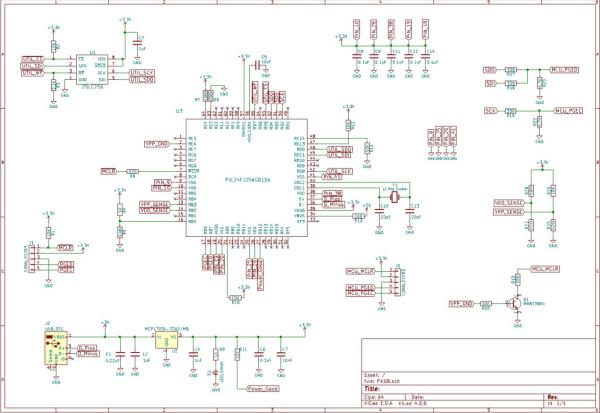Summary of PICKIT 3 MINI
The article describes a minimalist Pickit 3 programmer/debugger clone designed for programming primarily 3.3V PIC32 processors without unnecessary features like voltage adjustment or powering the target MCU. The design is based on Microchip's Pickit On-Board schematic, using essential components to mimic missing circuitry through voltage dividers and fixed signals. The goal is to integrate a simple, on-board programming/debugging device directly into prototype development boards. The author created a quick PCB layout as a proof of concept rather than a polished final product.
Parts used in the Pickit 3 Mini Project:
- 25LC256 EEPROM
- PIC24FJ256GB106 MCU
- USB Mini-B connector
- 3.3V voltage regulator
- Target MCU programming header
- Transistor for target MCU master-clear control
- Voltage dividers (for VPP_SENSE, VDD_SENSE, and 2.5V reference)
- Target MCU clock line
- Target MCU data line
Previously, I made a Pickit 3 clone – (See previous Blog Post). It works well, but I have often wondered just how little of its circuitry was needed to program and debug the boards I make. For instance – I primarily use the newer 3.3V PIC32 processors, so I really don’t need the ability to alter the voltage like the standard Pickit 3 can. I also have no real need for programming on the go, or even to provide power to the target MCU to program. Knowing this – I decided to see what I could do to remove the circuitry I didn’t need, yet still have a functioning programmer/debugger.
After a little research and looking at what Microchip had done with their starter kits, I arrived at the following schematic, which is based on their Pickit On-Board:
Here is a link to a PDF of the schematic: PDF Schematic
In the top left of the schematic is the 25LC256 EEPROM. Working our way down we see the main MCU the PIC24FJ256GB106 – and it’s programming header to the left, and below that is the USB Mini-B connector and the 3.3V regulator. Just above that and to the right is the target MCU programming header. To the right of that is a transistor that controls the target MCU master-clear line. Above that are a couple of voltage dividers that mimic the programming and target mcu voltages, and above that are the target MCU clock and Data lines.
This circuit looks to be the same basic underlying Pickit 3 circuit, but with some “faking” of inputs to mimic missing circuitry. For instance – the OTG programming switch would normally be on pin 21, but instead it is simply pulled high as there is no switch to pull it low. VPP_SENSE and VDD_SENSE are simply fed to the PIC by way of voltage dividers, as is the 2.5 volt reference at pin 16.
As it appeared I had everything I needed, I went about laying out the PCB. Since my ultimate goal with this project is to simply include these parts on my prototype development boards so that I can program and debug with an on-board device, I did not spend a lot of time routing the board. It is a quick and dirty that I am using as a proof of concept. If I intended to make these for long term use, I would have spent some time laying it out properly.
Read More: PICKIT 3 MINI

